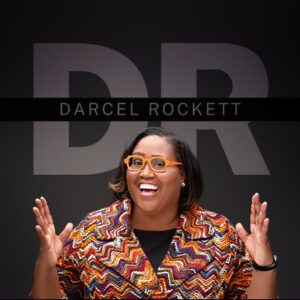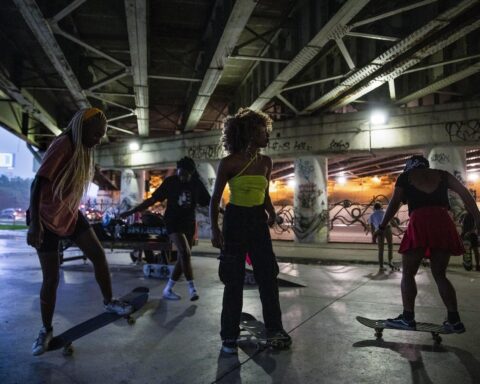On a brisk Sunday morning, half a dozen people congregate under the Red Line tracks at the intersection of Glenwood and Farwell avenues in Rogers Park to clean the sidewalk, stock inspirational posters into a recycled Chicago Reader newspaper box and write the names of those who have died at the hands of law enforcement.
It’s a regular occurrence since July Fourth.
From 11 a.m. to 1 p.m., Matthias Regan, a former North Central College professor of English literature, and members of PO Box Collective, which creates community in Rogers Park through arts programming, come together to maintain a Black Lives Matter memorial. According to Regan, the names go back as far as 2014. The memorial continues to grow, steps away from the collective’s space, with assistance from community members and volunteers. Passersby like Ivan Espino, of West Lawn, stop by to talk with the organizers and learn more about the ongoing project.
The white wall of the underpass is decorated with multicolored papers with the words “We Miss You” atop names like Curtis Stagger, who was killed May 28, 2019; Osaze Osagie, killed in State College, Pennsylvania, on March 20, 2019; and Michelle Cusseaux, killed in August 2014. Though some are faded, the papers still are vivid next to Black Lives Matter signs, placards that say “Stop Killing Us” and artwork with the words: “There is no justice in a racist system.”
Espino, proprietor of The Barber Life, stopped to add his cousin’s name to the stone wall. Alejandro “Alex” Nieto, a 28-year-old security guard, died after four San Francisco police officers fired 59 shots at him in Bernal Heights Park.
“He was a great person, a great person,” he said. “It really just doesn’t make sense. And 59 shots, I never heard someone got killed with 59 shots. Fifty-nine shots, that’s inhuman.”
Before Espino walked away, he gave thanks to those working on the project. Just seeing the wall while he was driving by made him stop and park to engage with the memorial.
“This is awesome,” Espino said. “I’m pretty sure everybody has a story, not just mine. I really appreciate what you guys are doing.”
Candles, flowers and incense rest alongside a can of beans, pine cones and tchotchkes on an altar below pictures of George Floyd, Black Lives Matter signs and colorful paper with handwritten names of the deceased. No one knows who left the altar, but Regan is happy that people are engaging with the memorial.
The wall is a mix of names of those who died locally and throughout the country. Images and brief write-ups of local faces and names like Sandra Bland, Laquan McDonald and Dominique Franklin Jr. are posted on the intricate altar below the posters and placards, in the middle of the wall.
“That was the original thought of it — to create a kind of altar space where like a celebrity dies … I sort of wanted to make that for all these unknown names, people you don’t know,” Regan said. “Part of it is just letting people really feel empowered to grieve, to participate, to do something.”
The project started with Regan, a self-proclaimed “unofficial artist” and activist who has been involved in movements critical of policing and the American prison system since 2002. Regan compiled the names of the deceased using reports like Operation Ghetto Storm that looked at extrajudicial killings of Black people, and databases like The Washington Post’s Fatal Force to find information about deaths from police violence.
He remembers the early days of trying to find cases under headlines of officer-involved shootings. Combing through public records and newspaper articles, Regan said he would try to reconstruct what happened, but not through the lens of law enforcement. Instead, he wanted to tell it through the lens of the deceased, “trying to record the lives, rather than the deaths.”
Regan said there are approximately 1,650 names on the memorial wall so far.
“I was working on trying to fill out the rest of the story from those who had been killed,” Regan said. “The real work was trying to find out who this person is. Were they visiting their nephew? I was using newspaper stories, compiling every single piece of journalism that I could find and then going through it and finding all these details that were sort of buried because they weren’t part of the main event. I was just trying to bring their story to light.”
It’s that mindset that Regan wants to get across with the Black Lives Matter memorial wall. And why he reached out to the collective to collaborate. What began as poems years ago morphed into an interactive website, and then this. A longtime Rogers Park resident, he thought after the George Floyd protests that something like this seemed possible.
So Regan and the collective created posters and the “We Miss You” name cards. He stocked stacks of the week’s posters, with the saying “Love Loudly” in various colorful fonts, in the newspaper vending machine before starting to hang a reconstituted rainbow flag. Regan said he has seen their posters in residences as far as Andersonville.
He said he feels public discourse has started to move on the idea of police violence. As the project grows, Regan has plans to repair the peeling white paint of the underpass, so more names can be added. Sophie Canadé, PO Box Collective founding member and art therapist, said that as awareness is raised and a place for communal mourning is provided, the design of the memorial is evolving in response to how the community uses it.
People “ask what this is, and that’s the beauty of it — we want people to know,” Canadé said. “They see all these names. These are people we’ve lost, and not just in all of time, but in recent history. We want people to know and feel the magnitude, the impact of what it means to have lost so many people. I think that we, as a people, need to recognize the devastation that is affecting communities.”
Regan said people are finding the project through word-of-mouth. Several people stopped to ask about the endeavor. A young woman with a Dunkin’ Donuts coffee in hand wanted information about how to help the team at a later date. An older woman with groceries walked past and expressed her thanks to those who erected the memorial.
Mara Goldman, a hand model, has been volunteering at the memorial since July. A native of Rogers Park, Goldman recognizes her privilege and said she feels honored to help.
“I was doing a lot of protests, and I saw this on Facebook. And when I came and saw it, I started crying, and I’ve literally been coming every Sunday,” she said. “The lowest age I’ve put on one of these pieces of paper was 12, and that was only a couple of weeks ago.” On Sunday, she revealed the name of a 9-year-old girl who died.
“Every week, we’ll have names that have come completely off that need to be replaced,” Canadé said. “That brings a commitment to the project. That’s the same as the fight for civil rights: You’re never going to be done, but you also can’t stop. It becomes the ritual that we do.”
Regan agrees.
“We’re going to keep going. … Part of the pain of making a memorial of this kind is that it doesn’t stop,” he said. “We invite and encourage everyone who cares about Black futures to contribute to the memorial. Take a poster, leave a name, light a candle, say a prayer. Remember that this small gesture barely registers the enormity of state violence. The next step is to defund the police.”







